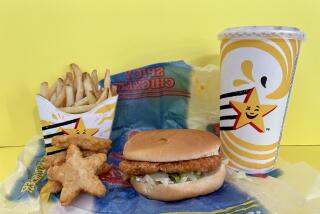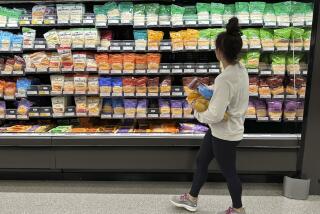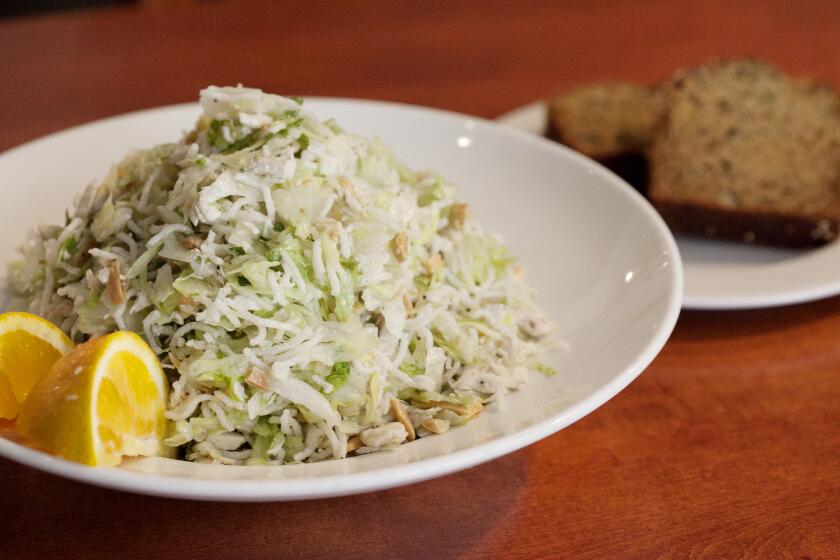Shopping With Grocery Guru : Supermarkets: Phil Lempert, whose mission is to increase consumer awareness of food trends, has a knack for sniffing out truths in the industry.
- Share via
BELLEVILLE, N.J. — Phil Lempert is “the supermarket guru.” As a food-industry expert and market analyst, he sees the supermarket not just in terms of bringing home the bacon, but as an emporium for insight.
Each year, Lempert visits hundreds of supermarkets and speaks with more than 5,000 consumers. He makes frequent radio and TV appearances and publishes The Lempert Report, a newsletter about the food industry. His mission: to increase consumer awareness of food trends.
Supermarkets are libraries of lifestyle and popular culture. “Where else can you find 20,000 different products under one roof?” he asks.
But they are also bastions of business savvy. The “Buy me!” marketing mentality is everywhere. From “plan-a-grams” (charts of what goes where, so it will sell better) to promotions to products, supermarkets spur you to spend that extra buck.
With a nose like Ralph Nader, figuratively speaking, Lempert has a knack for sniffing out truths in the food industry. He blew the whistle on the oat-bran craze, for example, and would now like to ban “no cholesterol” labels as misleading. He also complains that too many companies over-package products in this age of the garbage crisis.
Lempert provided a tour of two mid-size supermarkets in New Jersey: Grand Union and Pathmark.
The minute you walk into a supermarket, you’re going to be hit with an impression, Lempert says at Grand Union. What stores are doing now, he says, is placing consumers immediately in either the produce department or bakery. “They want to appeal to your senses--beautiful colors, freshness. . . . This is the first 10 to 15 seconds we’ve been in the store,” he says.
In Pathmark, the produce section is designed so that one must zigzag to get to the next aisle. The lights are right above the produce, not in the ceiling, so your eyes are drawn to the produce, Lempert points out.
Need milk? Typically it will be the farthest thing away from the door because it’s the biggest seller, he says. By the time you get to the milk, you’ve probably seen the rest of the store--and picked up other items.
Another relatively new feature is the “cheese table,” says Lempert at the end of aisle No. 1. It’s typically a well-arranged table of cheese, crackers and other imported or gourmet items that have upscale appeal--in other words, they’re more expensive. Sometimes a service person is there to help. Lempert takes a hunk of mild Cheddar cheese and brings it to the regular dairy aisle to compare prices. The “specialty” cheese is $4.99 a pound; the regular dairy case cheese is $3.34 a pound. Next, he takes a cheese spread labeled “light” and compares it with another brand labeled “ultra light.” “Any health claim on the front of the label is a signpost to turn to nutritional information,” Lempert says. “Don’t trust it.” (In fact, the “ultra light” brand contained more fat.)
Next comes an end-of-aisle display: jugs of cranberry-cocktail juice at the store’s “everyday low price.”
“That doesn’t mean you’re saving money, doesn’t mean it’s on sale,” Lempert says. Sometimes manufacturers have given the supermarket an incentive to put the product on display, such as a paid promotion. When you get to the aisle where the promoted item is normally stocked, compare, Lempert says.
The juice aisle is next. “There is a revolution going on in juices,” Lempert says. The Federal Department of Agriculture will soon require that companies state the percentage of real juice in such drinks and even break down the percentage of each juice in blended-juice drinks: “a very clear indication of how consumers will be better informed,” he says.
Aseptic juice containers (juice boxes), which many consider bad for the environment, may be convenient but “we don’t need this product,” Lempert says. Juice boxes are expensive, too: Here, it’s $1.63 per quart as opposed to 99 cents per quart of glass-bottled juice. “You’re paying a lot for packaging.”
As for hot drinks, Lempert predicts that herbal teas will skyrocket. Another high-growth area he sees is “all natural” sodas--but check the labels, he says.
“If a parent can make it down this aisle, they deserve a medal,” says Lempert on the breakfast cereal aisle. The aisle sign at Pathmark lists toys, children’s books, cereal and candy. “Healthy” adult cereals are on the top shelf, “commodity” cereals (corn flakes) on the bottom and kids’ cereals in the middle--at eye level, especially if you’re riding in a shopping cart.
“‘Oh Mommy, I want this!”’ Lempert says, mimicking a child, and picks up a box of “Bill and Ted’s” cereal--advertised as “a most awesome breakfast adventure.” It includes a free cassette tape case. Then we compare some prices: Teenage Mutant Ninja Turtles cereal is $4.47 a pound; corn flakes $1.49 a pound. “Typically, parents let their kids choose one cereal that they can have once a week,” Lempert says. Some supermarkets offer candy-free aisles and checkouts, and many parents are grateful. “More responsible retailers continue to do that,” Lempert says. But they are being challenged constantly by the candy companies, he adds.
“A lot is going on here,” says Lempert of the laundry detergent area. With the Downy refill, for example, you buy the 64-ounce plastic jug just once, then use it again when you buy the concentrated refill and add water. It’s less cost for the manufacturer, a lower price for consumers and easier on the environment, Lempert says. “We’re going to see more of that kind of thinking,” he adds. We pause in the frozen-foods section, which has grown tremendously in the past few years, especially frozen dinners. Lempert says he would like to see some movement toward healthier frozen meals, especially for children.
He also points out some good and bad packaging. Some microwave entrees include a plastic plate, which is ridiculous, he says. One study shows that many people throw away the plastic plate and use their own at home. And they are more expensive. “You’re paying $1.50 for the plate!” he says.
A Storehouse of Market Tips
How can consumers be more responsible and make food shopping more pleasurable? Food-industry expert Phil Lempert offers some tips:
* Make a list. Stick to it with a five-item-over limit. Ask yourself: “Do I really need it?”
* Read labels. “More and more people are reading labels, but that doesn’t mean they’re understanding them,” he says.
* Be skeptical. “You can’t be lazy. You can’t rely just on what you think a product is by the labeling or advertising.”
* Compare prices. If you’re happy with a product, stick with it. But you can still be open to other products.
* Keep the environment in mind. Ask yourself: How is the product packaged? Many times more packaging means more money and also wasted money. Plastic versus paper bag? Lempert says the life cycles of each are about the same, environmentally speaking. Best option: Bring your own. Be sure to wash your canvas and mesh bags.
* If you’re not happy, complain. Talk with the supermarket manager, or if it’s a product, call the 800 number. Or write Phil Lempert: Consumer Insight, P.O. Box 585, Montclair, N.J. 07042. Conversely, if a great product comes out it might worthwhile to call the 800 number as well.
More to Read
Eat your way across L.A.
Get our weekly Tasting Notes newsletter for reviews, news and more.
You may occasionally receive promotional content from the Los Angeles Times.








